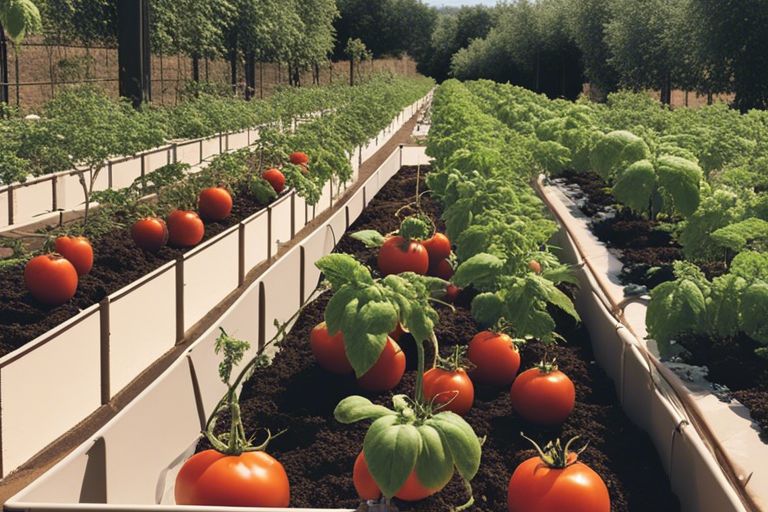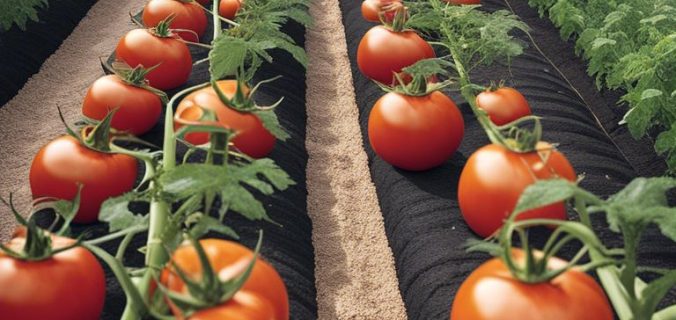Most gardeners know that tomatoes are a staple in many home gardens, but did you know that they can also be grown in an eco-friendly way that conserves water? In this how-to guide, we will explore tips and methods for growing tomatoes in a sustainable and water-efficient manner. From selecting the right varieties to implementing irrigation techniques, you can enjoy a bountiful tomato harvest while minimizing water usage. Let’s get started on your journey to growing eco-friendly tomatoes!
Key Takeaways:
- Choose drought-tolerant tomato varieties: Opt for varieties of tomatoes that require less water to thrive, such as Roma, Celebrity, or Sweet 100.
- Implement water-saving techniques: Utilize methods like drip irrigation, mulching, and companion planting to conserve water and promote healthier tomato plants.
- Harvest rainwater: Set up a rain barrel system to collect rainwater for watering your tomato plants, reducing the need for tap water and minimizing water waste.

Understanding Water Conservation in Tomato Growing
Factors Affecting Water Usage in Tomato Plants
To grow tomatoes while conserving water, it is crucial to understand the factors that affect water usage in tomato plants. Factors such as temperature, humidity, soil type, and plant age can all influence how much water tomato plants need. Additionally, the level of irrigation, the size of the plant, and the stage of growth will also impact water consumption. This knowledge can help tomato growers optimize their water usage and promote sustainable agricultural practices. This understanding will also aid in the growth of healthy and eco-friendly tomato plants.
Importance of Water Conservation in Agriculture
Affecting water conservation in agriculture is crucial due to the increasing water scarcity in many parts of the world. By conserving water in agricultural practices, farmers can help reduce overall water consumption and lessen the impact on the environment. Water conservation also plays a significant role in ensuring food security for future generations. Sustainable agricultural practices, such as efficient irrigation techniques and crop rotation, are vital for the preservation of water resources.
How-to Choose the Right Tomato Variety for Water Efficiency
Tips for Selecting Drought-Tolerant Tomato Varieties
Some tomato varieties are more drought-tolerant than others, making them ideal for water conservation in your garden. When choosing a drought-tolerant tomato variety, look for keywords like heat-resistant, drought-tolerant, or drought-resistant in the plant descriptions. Consider varieties such as Roma, Sun Gold, or Black Cherry, which require less water to thrive.
- Roma
- Sun Gold
- Black Cherry
Any water saved can make a significant impact on water conservation efforts in the long run.
Understanding the Role of Hybrid vs. Heirloom Tomatoes in Water Conservation
An understanding of the differences between hybrid and heirloom tomatoes can help in making water-conscious decisions for your garden. Hybrid tomatoes are bred for specific traits like disease resistance, higher yields, or drought tolerance, while heirloom tomatoes are open-pollinated varieties with unique flavors and traits. Tomatoes bred for drought tolerance can be more water-efficient in the long term.
Tomatoes are a staple in many home gardens, and choosing the right variety can have a significant impact on water conservation efforts. While heirloom tomatoes offer unique flavors, hybrid varieties bred for drought tolerance can help save water and promote sustainability in your garden. Making informed choices based on the specific needs of your garden can lead to a more water-efficient tomato harvest.
Water-Saving Techniques for Tomato Growers
All A Guide to Growing Organic Tomatoes suggests various water-saving techniques for tomato growers to promote eco-friendly practices and efficient water conservation.
How-to Implement Mulching and Cover Cropping for Water Retention
On top of watering, mulching and cover cropping are important practices to retain moisture in the soil and reduce evaporation. Mulching with materials like straw, leaves, or grass clippings can help regulate soil temperature and retain moisture, while cover cropping with nitrogen-fixing plants can improve soil structure, promoting water retention.
Tips for Efficient Irrigation Systems and Scheduling
Tomato growers can benefit from utilizing drip irrigation systems or soaker hoses to deliver water directly to the roots, minimizing evaporation and water waste. Additionally, scheduling irrigation during the early morning or late evening can reduce water loss due to evaporation. Knowing the water requirements of tomatoes and adjusting irrigation schedules accordingly is key to efficient water usage.
- Drip irrigation: Delivers water directly to roots.
- Soaker hoses: Ideal for minimizing water waste.
- Early morning or late evening irrigation: Reduces evaporation.
Another important technique for water conservation is monitoring soil moisture levels regularly to avoid overwatering. Adjusting the irrigation schedule based on weather conditions and plant growth stage can help optimize water usage for tomato plants. Knowing the signs of both overwatering and underwatering is crucial for maintaining healthy tomato plants and conserving water efficiently.
Creating an Eco-Friendly Tomato Garden
How-to Design a Water-Conscious Garden Layout
One way to design a water-conscious garden layout for your eco-friendly tomato garden is to group plants with similar water needs together. This will help you efficiently water your plants without wastage.
Factors to Consider for Soil Health and Water Absorption
EcoFriendly gardening involves considering factors that promote soil health and water absorption in your tomato garden. Some of these factors include proper drainage, organic mulching, and composting to improve soil quality and water retention. Any excess water can lead to root rot and nutrient leaching.
- Proper drainage
- Organic mulching
- Composting
Plus, it’s important to monitor soil moisture levels regularly to ensure your tomato plants receive optimal hydration while avoiding waterlogging. Any imbalance in soil health can hinder plant growth and tomato production.
To wrap up
Following this guide on growing eco-friendly tomatoes can help us conserve water and contribute to a more sustainable environment. By implementing simple practices like using mulch, drip irrigation, and rainwater harvesting, we can reduce water waste while still enjoying a bountiful tomato harvest. Let’s continue to be mindful of our water usage in the garden and strive to promote eco-friendly gardening practices for a healthier planet.
FAQ
Q: Why are tomatoes and water conservation important?
A: Tomatoes are a popular crop that require a significant amount of water to grow. By practicing water conservation techniques, such as drip irrigation and mulching, you can reduce water usage and minimize waste, contributing to a more sustainable and eco-friendly environment.
Q: What are some water conservation techniques for growing tomatoes?
A: Some effective water conservation techniques for growing tomatoes include using drip irrigation systems, mulching around plants to retain moisture, planting tomatoes in well-draining soil, and collecting rainwater for irrigation purposes. These methods can help reduce water usage while promoting healthy tomato growth.
Q: How can I create an eco-friendly tomato garden?
A: To create an eco-friendly tomato garden, you can incorporate practices such as using organic fertilizers and pesticides, companion planting to naturally repel pests, and rotating crops to maintain soil health. Additionally, choosing tomato varieties that are well-suited to your climate and soil conditions can help reduce water and resource consumption while still yielding a bountiful tomato harvest.

